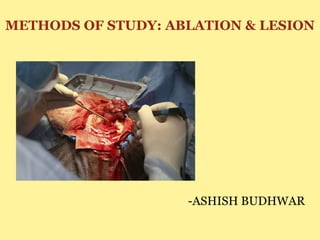
Ablation & lesion
- 1. METHODS OF STUDY: ABLATION & LESION -ASHISH BUDHWAR
- 2. PHYSIOLOGICAL PSYCHOLOGY It is that branch of psychology that connects behavior & other mental processes like emotions, feelings & thinking to bodily processes & specifically to the processes of the brain & the nervous system.
- 3. METHODS OF RESEARCH IN PHYSIOLOGICAL PSYCHOLOGY ABLATION AND LESION STUDIES ELECTROENCEPHALOGY (E.E.G) MAGNETOENCEPHALOGY (M.E.G) BRAIN STIMULATION IMAGING TECHNIQUES
- 4. ABLATION & LESION Ablation and Lesion studies are important methods of research to study the relation between the functioning of the brain and the behavior of organisms. A lesion in brain of organisms is a damaged part of the brain that results in the destruction of neurons. Lesions can come from natural sources like injury, disease or ageing. Ablation is the purposeful creation of a lesion in the brain in experimental organisms.
- 5. ABLATION AND LESION Damage/Lesion in a part of brain can produce different behavioral and psychological effects. For example, 1. Damage to the front end of the brain can disturb the ability to make decisions and to inhibit socially inappropriate behaviors. 2. Damage to the back of the brain disturbs the vision.
- 6. RATIONALE BEHIND THE METHOD The rationale behind the method of ablation is that; after a particular lesion occurs or is created or removed, and the organism can no longer perform a function/behavior which he was performing previously or there is a change in behavior, an inference can be made that the area destroyed in brain is responsible for that particular function/behavior.
- 7. LESION STUDIES Four types of ablation lesions are discussed here: 1. Aspiration lesions, 2. Radio-frequency lesions, 3. Knife cuts, and 4. Reversible lesions.
- 8. ASPIRATIONAL LESIONS Aspiration is a useful method of lesion when a lesion is to made in the visible and accessible part of the brain such as the cortical region. After an incision is made in the scalp, the cortical tissue is drawn off by suction through a fine-tipped handheld glass pipette. The aspiration method requires great skill as the underlying white matter in the brain and the blood vessels are resistant to suction, a skilled surgeon can delicately peel off the required part without damaging any blood vessels or the white matter.
- 9. METHODS OF BRAIN STUDY
- 10. RADIO FREQUENCY LESIONS This method of lesion study is useful when a lesion has to be made and studied in the subcortical region of the brain. Such lesions are made by passing high frequency radio currents through the target tissue by a stereotaxically positioned electrode. The heat from the current destroys the tissue. Te size and the shape of the lesion is determined by the duration and the intensity of the current and the configuration of the electrode tip.
- 11. KNIFE CUT LESIONS This method is useful in for sub-cortical lesion studies. It involves the cutting or sectioning to cut off the conduction in a nerve or a tract. It requires great precision as a tiny, well-placed cut can unambiguously accomplish this task without producing extensive damage to surrounding tissue.
- 12. REVERSIBLE LESIONS Reversible lesions are useful alternatives to destructive lesions. Reversible lesions are methods for temporarily eliminating the activity in a particular area of the brain while tests are being conducted. The advantage of reversible lesions is that the same subjects can be repeatedly tested. Reversible lesions can be produced by cooling the target structure or by injecting an anesthetic (e.g., lidocaine) into it.
- 13. INTERPRETING LESION RESULTS Lesion effects are deceptively difficult to interpret. Because the structures of the brain are small, convoluted, and tightly packed together, even a highly skilled surgeon cannot completely destroy a structure without producing significant damage to adjacent structures. For example, a lesion that leaves major portions of the amygdala intact and damages an assortment of neighboring structures comes to be thought of simplistically as an amygdala lesion. Also care must be taken while interpreting the results of ablation. It is not easy to determine functions in animals as it is in humans. For eg: to determine that an animal has become blind, it will require complex tests, while in humans the subject can simply speak an tell the effect of the ablation.
- 14. ETHICAL CONCERNS IN ABLATION The method of ablation, destroying brain tissues to study their functioning, would be unethical in humans. Therefore experimental organisms whose body functions and anatomies are similar to humans are chosen to get a close guess about the human brain functioning. Ablation method can be used as a treatment for dangerous and damaging disorders of the brain that can be a threat to an individual such as epileptic seizures.
- 15. CONCLUSION Since, one part of the brain cannot be responsible for all behaviors, the aim is to determine what functions combine up to perform particular behaviors. So the procedure, as well as the interpretation of the results is a very complex task and requires utter care or else the results can mislead the research.
Editor's Notes
- 1848 CASE OF PHINEAS GAGE
- Stereotaxically placed knife
- AMYGDALA – It is an almond shaped set of neurons located deep in the brain’s medial temporal lobe & forms a part of the limbic system & plays a key role in the processing of emotions.